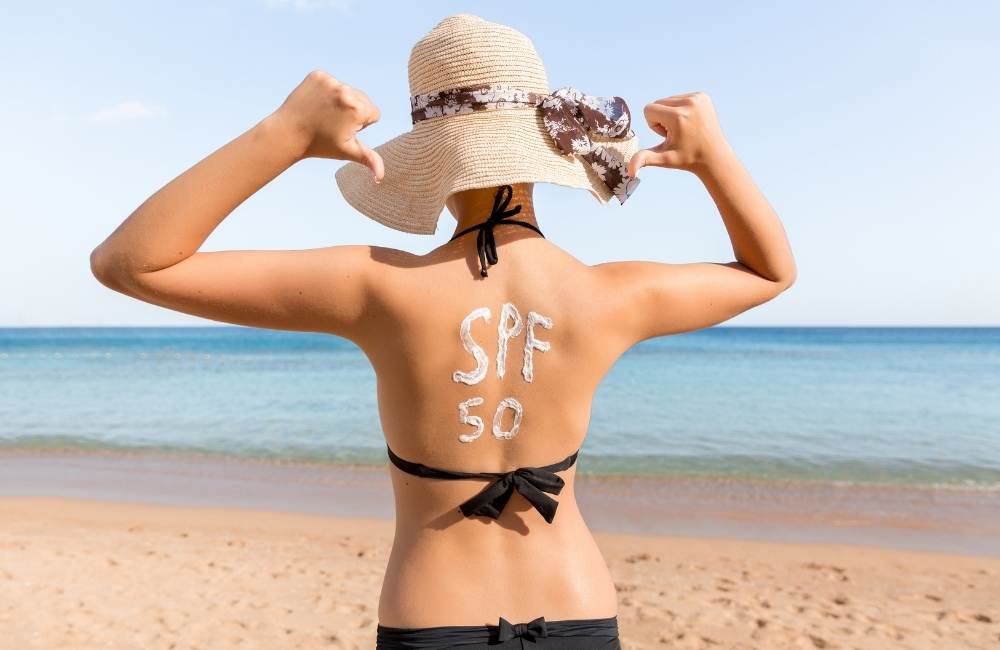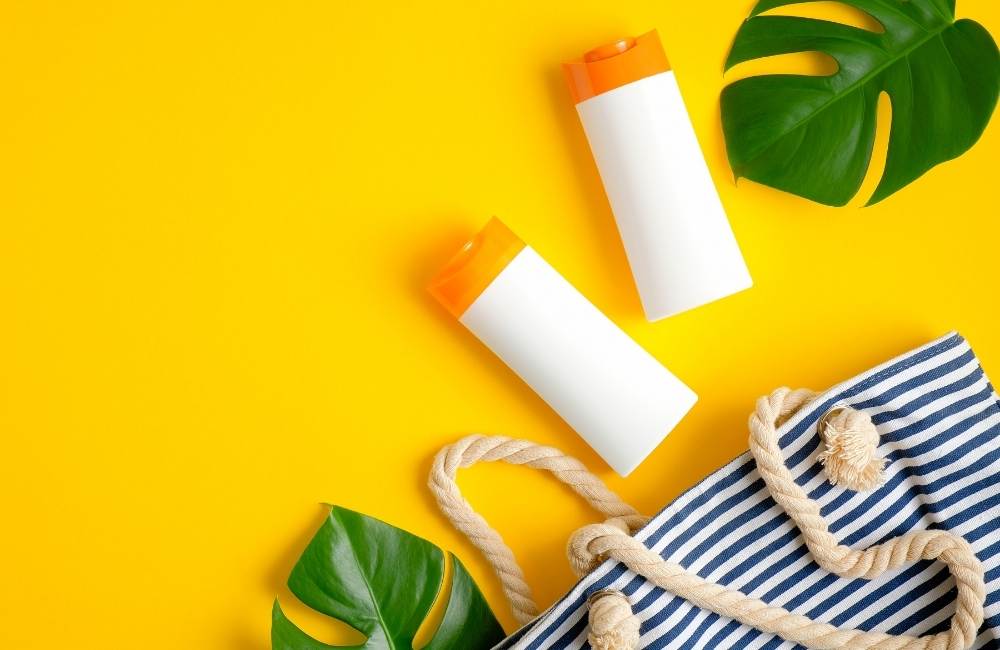While summer is all about everything bright and beautiful and about protecting our skin from the harmful rays of the sun, sunscreen, also known as sunblock, is an essential component when it comes to protecting our skin from the harmful UV rays of the sun.
Sunscreens are available in the form of lotions, sprays, gel, and cream. Even if we are supposed to wear it all year round, some of us don’t think about it too much until spring or summer rolls around because we can physically see the sun at this time.
In this article, we will share with you all the benefits of sunscreen, why you need to use sunscreen with higher SPF, how to DIY your own sunscreen at home, and why homemade sunscreen is better than commercial ones.
Contents
Benefits of Using a Sunscreen Every Day

Sunscreen is the best product you will ever get to protect your skin and keep it youthful and glowy for as long as possible. Here are some essential benefits of using sunscreen every day:
- Sunscreen acts as a shield against the harmful UV rays of the sun. Prolonged exposure to the sun can damage the skin’s layers and penetrate deep, causing premature aging and other skin disorders. Sunscreen blocks these harmful rays from triggering such skin issues.
- Sunscreen prevents premature aging. Regular use of sunscreen can reduce the signs of fine lines and wrinkles and can preserve the much-loved youth for long. Studies show that women who use sunscreen daily age 24% less than those who do not use sunscreen or use sunscreen occasionally.
- Using sunscreen daily reduces the risk of skin cancer, especially melanoma, by 50%. This cancer mostly attacks women in their late 20s and is probably one of the worst skin cancer types.
- It reduces pigments and dark spots. If you have lots of dark spots and acne scars on your skin, then regular use of sunscreen can reduce its appearance.
- Sunscreen prevents sunburn that weakens your skin’s barrier and makes it prone to bruises and rashes. Applying sunscreen daily can protect your skin barrier, therefore, preventing sunburn.
- Sunscreen prevents your skin from tanning. Unless you want to go for a tan, applying sunscreen is essential in maintaining an even skin tone. It is also necessary to remember that you are prone to skin disorders and diseases while you are out in the sun getting some lovely tan. Therefore, it is recommended to wear a low SPF sunscreen to get that desired tan and protect your skin from damages.
- Proteins such as keratin and collagen, and elastin makes up our skin. With prolonged exposure to the sun, these substances can damage. Therefore, regular use of sunscreen can protect these necessary substances, maintaining glowing skin.
What is SPF and the benefits of using a sunscreen with SPF 50?
SPF, aka sun protection factor, is used to measure how well your skin will be protected from the sun’s damage, such as sunburns and skin cancer. It is assumed that if your skin burns after 20 minutes in the sun, then an SPF 30 can protect you from the sun’s rays for about 10 hours.
To get maximum protection, you need to look for a sunscreen that protects you from UVA and UVB rays. This means that your sunscreen should be able to protect you from both suntan and sunburn.
Different SPF has different capacities to block the sun’s harmful rays. For example, SPF 15 blocks 93% of the sun’s harmful rays, SPF 30 blocks 97% of the sun’s harmful rays, while SPF 50 blocks at least 98% of the sun’s rays. So you should wear at least SPF 30 while out in the sun.
A sunscreen with SPF 50 will provide you 50 times more protection from the sun. With SPF 50, only a small number of damaging sun rays can penetrate the skin. Therefore it is essential to reapply even your SPF 50 as you normally would. Therefore, most dermatologists recommend using an SPF 30 and 50. However, going over SPF 50 can be counterproductive.
People are often misled because higher SPF will provide higher protection, but this is not always the case. Using a higher SPF does not mean that you do not need to seek shade, and you are all protected. Sunscreen with higher SPF gives you a false sense of security, and you damage your skin by upping your time in the sun. This prolonged exposure to the sun can be the cause of skin cancer.
Natural Ingredients and their SPF
Here is a list of all the ingredients and their respective SPF:
- Almond oil: SPF almost around 5
- Coconut oil: SPF around 4-5
- Zinc oxide or titanium dioxide: the SPF of this depends on how much is used, which is probably around 2-20
- Shea butter: SPF around 4-6
- Raspberry seed oil: SPF around 25-50
- Carrot seed oil: SPF around 35-50
How to Make your DIY Homemade Sunscreen SPF 50

Things you need:
- Almond oil- ½ cup
- Coconut oil- ¼ cup
- Zinc oxide or titanium dioxide- 2 TBSP
- Shea butter- 2 TBSP
- Raspberry seed oil- 1 TSP
- Carrot seed oil- 1 TSP
- Beeswax- ¼ cup
Procedure:
- Mix all the ingredients, excluding zinc oxide, in a bowl.
- Take another container big enough to fill the bowl in it and fill it halfway with water. Place the utensil on the stove and put it on the boil in medium heat.
- Place the bowl of mixture in the container and heat it until all the ingredients melt well. Keep stirring it continuously, thereby avoiding it to stick at the bottom.
- After all the ingredients are mixed well, pour in the zinc oxide or titanium dioxide and stir it well until all the ingredients are mixed properly.
- Allow it to cool and store it in a cool jar at either room temperature or in the refrigerator to increase the product’s shelf life.
This sunscreen is not waterproof or water-resistant, and hence it needs to be reapplied every time you sweat. Also, avoid inhaling zinc oxide because it can cause adverse effects. The usage of beeswax should be used to determine the consistency of the sunscreen. It should be used less to get a lighter consistency and used more if you want a thicker consistency.
Why is homemade sunscreen better than commercial ones?
Whether to use homemade sunscreen or not is always debatable. Homemade sunscreen might not be as good as the store brought one, but they work just fine. These sunscreens can come in handy during emergencies. Store brought sunscreen might contain several harmful chemicals, so here is why you should make your own sunscreen at home.
Homemade sunscreen can prevent the usage of hormone-disrupting chemicals. Most stores bought sunscreens have harmful chemicals, increasing the risk of skin cancer and disturbing the endocrine hormones. A chemical named Oxybenzone, a hormone disruptor is not safe for children.
Homemade sunscreen can also save our environment by protecting the coral reefs. Store-bought sunscreen contains chemicals that the researchers have termed as ‘swimmer pollution’ threatening to the coral reefs. Millions of swimmers come to swim to the oceans every year, and their sunscreen washes off, which is found to awaken dormant viruses in symbiotic algae, which provides food and color to the corals.
Bottom Line
Many scientists argue that homemade sunscreen can be dangerous and should not be used regularly because it does not provide the right proportion of SPF. Stepping out in the sun with these sunscreens can risk the intensity of sun exposure.
We agree that these homemade sunscreens are not lab tested like the commercial ones, and they may not be 100% perfect, but they are still pretty good alternatives to all those chemical sunscreens. The only conclusion we can come to is to use your common sense.
Read the labels thoroughly before buying sunscreen and also equally evaluate your exposure to the sun. It is mere common sense that prolonged exposure to the sun will risk your skin danger no matter whatever sunscreen you use.
hello Mariyam, does ur recipe leave a white cast?
What happens if I add the zinc oxide with everything when heated?
I misread your directions and added everything in the double broiler… will it lose its effectiveness?
Hi Savanna,
You won’t lose its composition, but it will change color.
I am interested in making my own sunscreen lotion and have a question about how much Titanium Dioxide, Raspberry seed oil and Carrot seed oil to a gallon of carrier oil to make a SPF50 to protect tattoo ink.
Hi Mariyam, can you tell me how the SPF number is calculated from the ingredients? Are the SPF numbers per ingredient added together? Thanks!
I have 2 questions please…
1. How many ml is 1/2 cup and 1/4 cup?
2. I tried this but struggled with melting zinc oxide. It left white residue at the bottom of my pan. Have I done anything wrong? Any tips to avoid this please?….
I’m not the poster but this happened to me.
According to the instructions, you’re only suppose to put the zinc oxide AFTER everything has been heated and melted. I accidentally cooked it the first time and it left that white residue, but when I didn’t cook it I wasn’t left with it, hope this helps 🙂
Thank you so much for sharing the recipe, just one question:
How much is the cup in ml?
thank you so much for your answer in advance!